Basque vs Jamaican Community Comparison
COMPARE
Basque
Jamaican
Social Comparison
Social Comparison
Basques
Jamaicans
6,979
SOCIAL INDEX
67.3/ 100
SOCIAL RATING
133rd/ 347
SOCIAL RANK
821
SOCIAL INDEX
5.8/ 100
SOCIAL RATING
337th/ 347
SOCIAL RANK
Jamaican Integration in Basque Communities
The statistical analysis conducted on geographies consisting of 135,219,135 people shows a mild positive correlation between the proportion of Jamaicans within Basque communities in the United States with a correlation coefficient (R) of 0.329. On average, for every 1% (one percent) increase in Basques within a typical geography, there is an increase of 0.170% in Jamaicans. To illustrate, in a geography comprising of 100,000 individuals, a rise of 1,000 Basques corresponds to an increase of 169.9 Jamaicans.
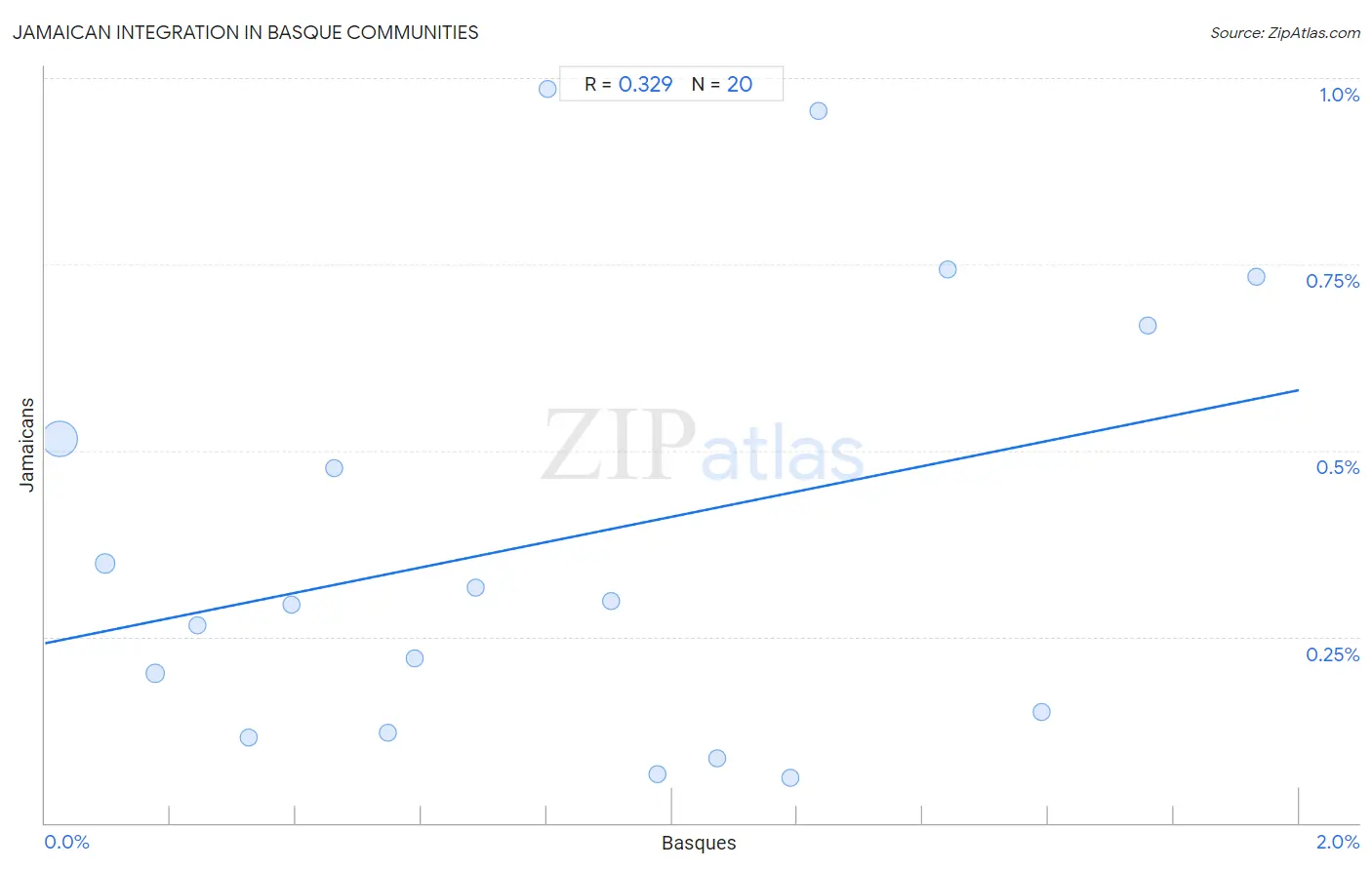
Basque vs Jamaican Income
When considering income, the most significant differences between Basque and Jamaican communities in the United States are seen in wage/income gap (28.8% compared to 19.6%, a difference of 47.0%), householder income ages 45 - 64 years ($103,387 compared to $88,327, a difference of 17.1%), and median family income ($104,760 compared to $90,581, a difference of 15.7%). Conversely, both communities are more comparable in terms of median female earnings ($38,352 compared to $38,670, a difference of 0.83%), householder income under 25 years ($51,818 compared to $50,929, a difference of 1.7%), and median earnings ($46,399 compared to $43,343, a difference of 7.0%).

| Income Metric | Basque | Jamaican |
| Per Capita Income | Excellent $45,086 | Tragic $39,231 |
| Median Family Income | Good $104,760 | Tragic $90,581 |
| Median Household Income | Good $87,001 | Tragic $76,583 |
| Median Earnings | Average $46,399 | Tragic $43,343 |
| Median Male Earnings | Good $55,370 | Tragic $48,632 |
| Median Female Earnings | Tragic $38,352 | Poor $38,670 |
| Householder Age | Under 25 years | Fair $51,818 | Tragic $50,929 |
| Householder Age | 25 - 44 years | Good $96,709 | Tragic $83,933 |
| Householder Age | 45 - 64 years | Excellent $103,387 | Tragic $88,327 |
| Householder Age | Over 65 years | Excellent $62,653 | Tragic $54,560 |
| Wage/Income Gap | Tragic 28.8% | Exceptional 19.6% |
Basque vs Jamaican Poverty
When considering poverty, the most significant differences between Basque and Jamaican communities in the United States are seen in receiving food stamps (10.3% compared to 16.4%, a difference of 60.0%), family poverty (8.1% compared to 11.1%, a difference of 35.8%), and seniors poverty over the age of 65 (10.2% compared to 13.6%, a difference of 34.1%). Conversely, both communities are more comparable in terms of single mother poverty (29.5% compared to 29.9%, a difference of 1.3%), single female poverty (21.3% compared to 21.6%, a difference of 1.3%), and single male poverty (13.0% compared to 13.2%, a difference of 1.5%).
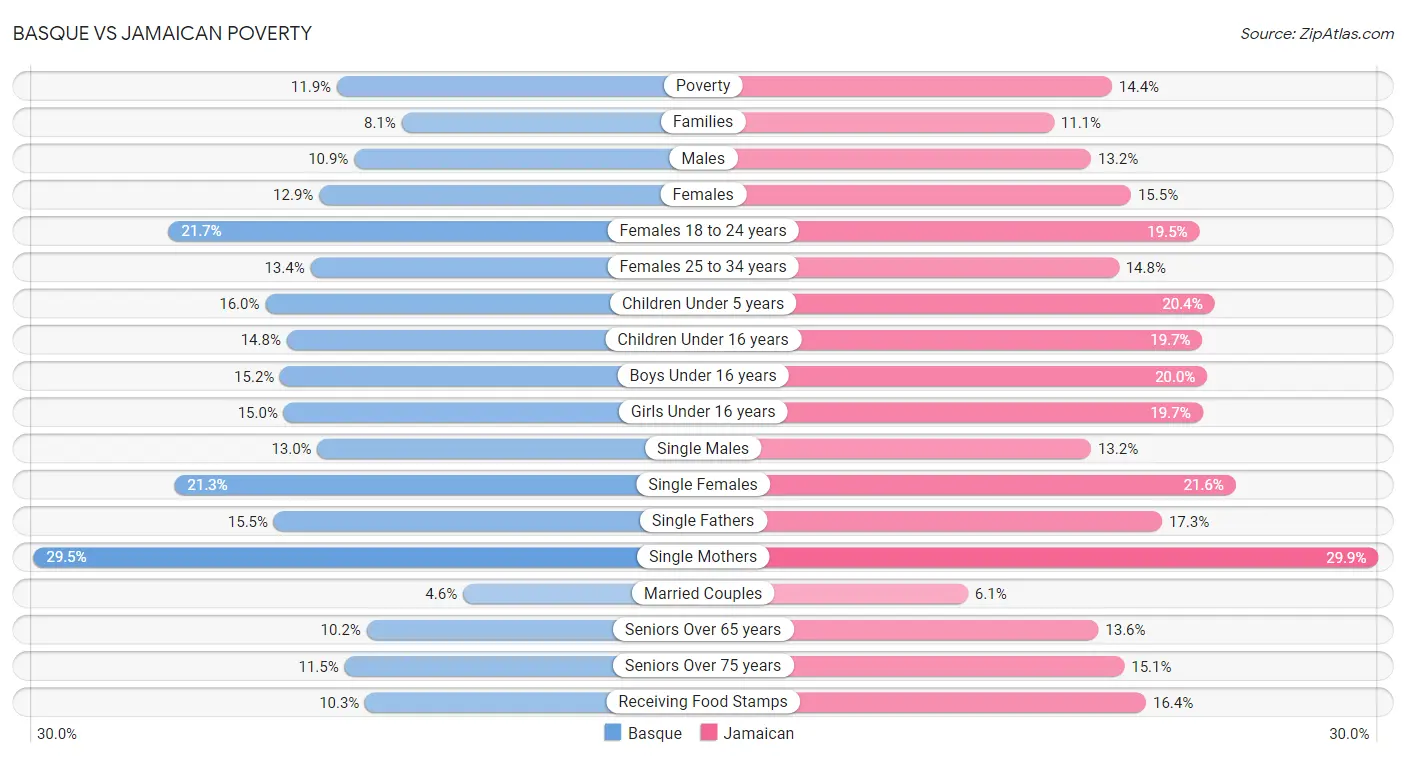
| Poverty Metric | Basque | Jamaican |
| Poverty | Excellent 11.9% | Tragic 14.4% |
| Families | Exceptional 8.1% | Tragic 11.1% |
| Males | Good 10.9% | Tragic 13.2% |
| Females | Excellent 12.9% | Tragic 15.5% |
| Females 18 to 24 years | Tragic 21.7% | Exceptional 19.5% |
| Females 25 to 34 years | Average 13.4% | Tragic 14.8% |
| Children Under 5 years | Exceptional 16.0% | Tragic 20.4% |
| Children Under 16 years | Exceptional 14.8% | Tragic 19.7% |
| Boys Under 16 years | Exceptional 15.2% | Tragic 20.0% |
| Girls Under 16 years | Exceptional 15.0% | Tragic 19.7% |
| Single Males | Fair 13.0% | Tragic 13.2% |
| Single Females | Fair 21.3% | Poor 21.6% |
| Single Fathers | Exceptional 15.5% | Tragic 17.3% |
| Single Mothers | Fair 29.5% | Poor 29.9% |
| Married Couples | Exceptional 4.6% | Tragic 6.1% |
| Seniors Over 65 years | Exceptional 10.2% | Tragic 13.6% |
| Seniors Over 75 years | Exceptional 11.5% | Tragic 15.1% |
| Receiving Food Stamps | Exceptional 10.3% | Tragic 16.4% |
Basque vs Jamaican Unemployment
When considering unemployment, the most significant differences between Basque and Jamaican communities in the United States are seen in male unemployment (5.0% compared to 6.6%, a difference of 31.2%), unemployment (5.0% compared to 6.3%, a difference of 27.1%), and unemployment among youth under 25 years (11.4% compared to 14.4%, a difference of 26.5%). Conversely, both communities are more comparable in terms of unemployment among ages 65 to 74 years (5.4% compared to 5.6%, a difference of 4.4%), unemployment among ages 55 to 59 years (4.9% compared to 5.2%, a difference of 5.9%), and unemployment among seniors over 65 years (5.1% compared to 5.5%, a difference of 8.3%).
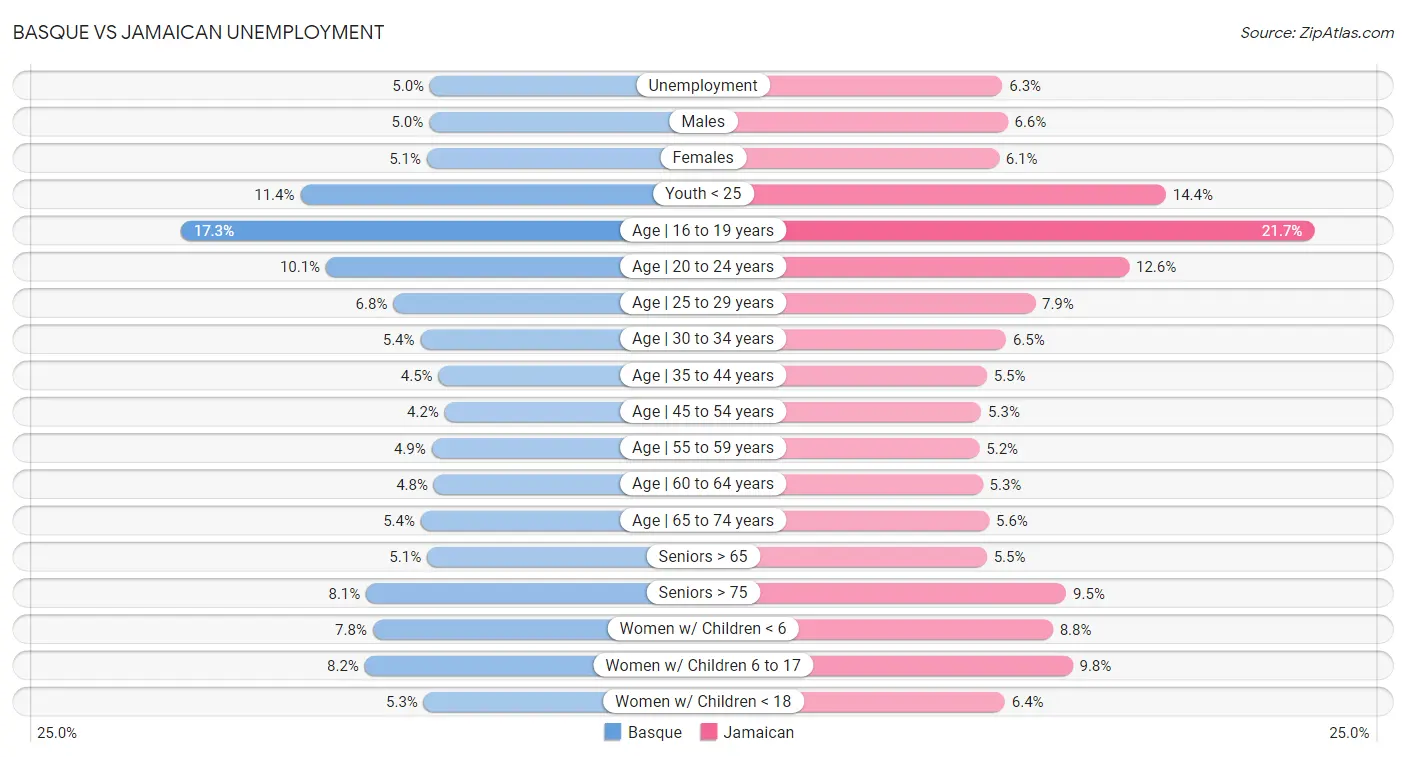
| Unemployment Metric | Basque | Jamaican |
| Unemployment | Exceptional 5.0% | Tragic 6.3% |
| Males | Exceptional 5.0% | Tragic 6.6% |
| Females | Excellent 5.1% | Tragic 6.1% |
| Youth < 25 | Excellent 11.4% | Tragic 14.4% |
| Age | 16 to 19 years | Excellent 17.3% | Tragic 21.7% |
| Age | 20 to 24 years | Excellent 10.1% | Tragic 12.6% |
| Age | 25 to 29 years | Fair 6.8% | Tragic 7.9% |
| Age | 30 to 34 years | Average 5.4% | Tragic 6.5% |
| Age | 35 to 44 years | Excellent 4.5% | Tragic 5.5% |
| Age | 45 to 54 years | Exceptional 4.2% | Tragic 5.3% |
| Age | 55 to 59 years | Fair 4.9% | Tragic 5.2% |
| Age | 60 to 64 years | Excellent 4.8% | Tragic 5.3% |
| Age | 65 to 74 years | Fair 5.4% | Tragic 5.6% |
| Seniors > 65 | Good 5.1% | Tragic 5.5% |
| Seniors > 75 | Exceptional 8.1% | Tragic 9.5% |
| Women w/ Children < 6 | Fair 7.8% | Tragic 8.8% |
| Women w/ Children 6 to 17 | Exceptional 8.2% | Tragic 9.8% |
| Women w/ Children < 18 | Excellent 5.3% | Tragic 6.4% |
Basque vs Jamaican Labor Participation
When considering labor participation, the most significant differences between Basque and Jamaican communities in the United States are seen in in labor force | age 16-19 (39.3% compared to 33.2%, a difference of 18.2%), in labor force | age 20-24 (76.5% compared to 72.7%, a difference of 5.2%), and in labor force | age 35-44 (83.6% compared to 84.4%, a difference of 1.0%). Conversely, both communities are more comparable in terms of in labor force | age 45-54 (82.0% compared to 82.0%, a difference of 0.090%), in labor force | age 20-64 (78.7% compared to 78.9%, a difference of 0.27%), and in labor force | age 30-34 (84.0% compared to 84.3%, a difference of 0.41%).

| Labor Participation Metric | Basque | Jamaican |
| In Labor Force | Age > 16 | Tragic 64.2% | Poor 64.9% |
| In Labor Force | Age 20-64 | Tragic 78.7% | Tragic 78.9% |
| In Labor Force | Age 16-19 | Exceptional 39.3% | Tragic 33.2% |
| In Labor Force | Age 20-24 | Exceptional 76.5% | Tragic 72.7% |
| In Labor Force | Age 25-29 | Tragic 83.4% | Tragic 83.9% |
| In Labor Force | Age 30-34 | Tragic 84.0% | Tragic 84.3% |
| In Labor Force | Age 35-44 | Tragic 83.6% | Good 84.4% |
| In Labor Force | Age 45-54 | Tragic 82.0% | Tragic 82.0% |
Basque vs Jamaican Family Structure
When considering family structure, the most significant differences between Basque and Jamaican communities in the United States are seen in single mother households (5.7% compared to 8.2%, a difference of 43.9%), births to unmarried women (29.7% compared to 38.5%, a difference of 29.4%), and married-couple households (48.4% compared to 40.9%, a difference of 18.5%). Conversely, both communities are more comparable in terms of family households (64.7% compared to 64.2%, a difference of 0.73%), divorced or separated (12.6% compared to 12.9%, a difference of 2.6%), and family households with children (27.7% compared to 26.9%, a difference of 2.8%).

| Family Structure Metric | Basque | Jamaican |
| Family Households | Excellent 64.7% | Average 64.2% |
| Family Households with Children | Good 27.7% | Tragic 26.9% |
| Married-couple Households | Exceptional 48.4% | Tragic 40.9% |
| Average Family Size | Tragic 3.19 | Exceptional 3.31 |
| Single Father Households | Tragic 2.5% | Average 2.3% |
| Single Mother Households | Exceptional 5.7% | Tragic 8.2% |
| Currently Married | Exceptional 48.1% | Tragic 41.4% |
| Divorced or Separated | Tragic 12.6% | Tragic 12.9% |
| Births to Unmarried Women | Exceptional 29.7% | Tragic 38.5% |
Basque vs Jamaican Vehicle Availability
When considering vehicle availability, the most significant differences between Basque and Jamaican communities in the United States are seen in no vehicles in household (7.8% compared to 17.9%, a difference of 130.9%), 4 or more vehicles in household (8.4% compared to 4.6%, a difference of 82.1%), and 3 or more vehicles in household (24.3% compared to 15.2%, a difference of 59.5%). Conversely, both communities are more comparable in terms of 1 or more vehicles in household (92.4% compared to 82.1%, a difference of 12.5%), 2 or more vehicles in household (61.4% compared to 45.8%, a difference of 34.1%), and 3 or more vehicles in household (24.3% compared to 15.2%, a difference of 59.5%).

| Vehicle Availability Metric | Basque | Jamaican |
| No Vehicles Available | Exceptional 7.8% | Tragic 17.9% |
| 1+ Vehicles Available | Exceptional 92.4% | Tragic 82.1% |
| 2+ Vehicles Available | Exceptional 61.4% | Tragic 45.8% |
| 3+ Vehicles Available | Exceptional 24.3% | Tragic 15.2% |
| 4+ Vehicles Available | Exceptional 8.4% | Tragic 4.6% |
Basque vs Jamaican Education Level
When considering education level, the most significant differences between Basque and Jamaican communities in the United States are seen in no schooling completed (1.8% compared to 2.4%, a difference of 31.9%), doctorate degree (1.9% compared to 1.5%, a difference of 31.9%), and professional degree (4.6% compared to 3.7%, a difference of 24.8%). Conversely, both communities are more comparable in terms of nursery school (98.2% compared to 97.6%, a difference of 0.66%), kindergarten (98.2% compared to 97.6%, a difference of 0.68%), and 1st grade (98.2% compared to 97.5%, a difference of 0.68%).
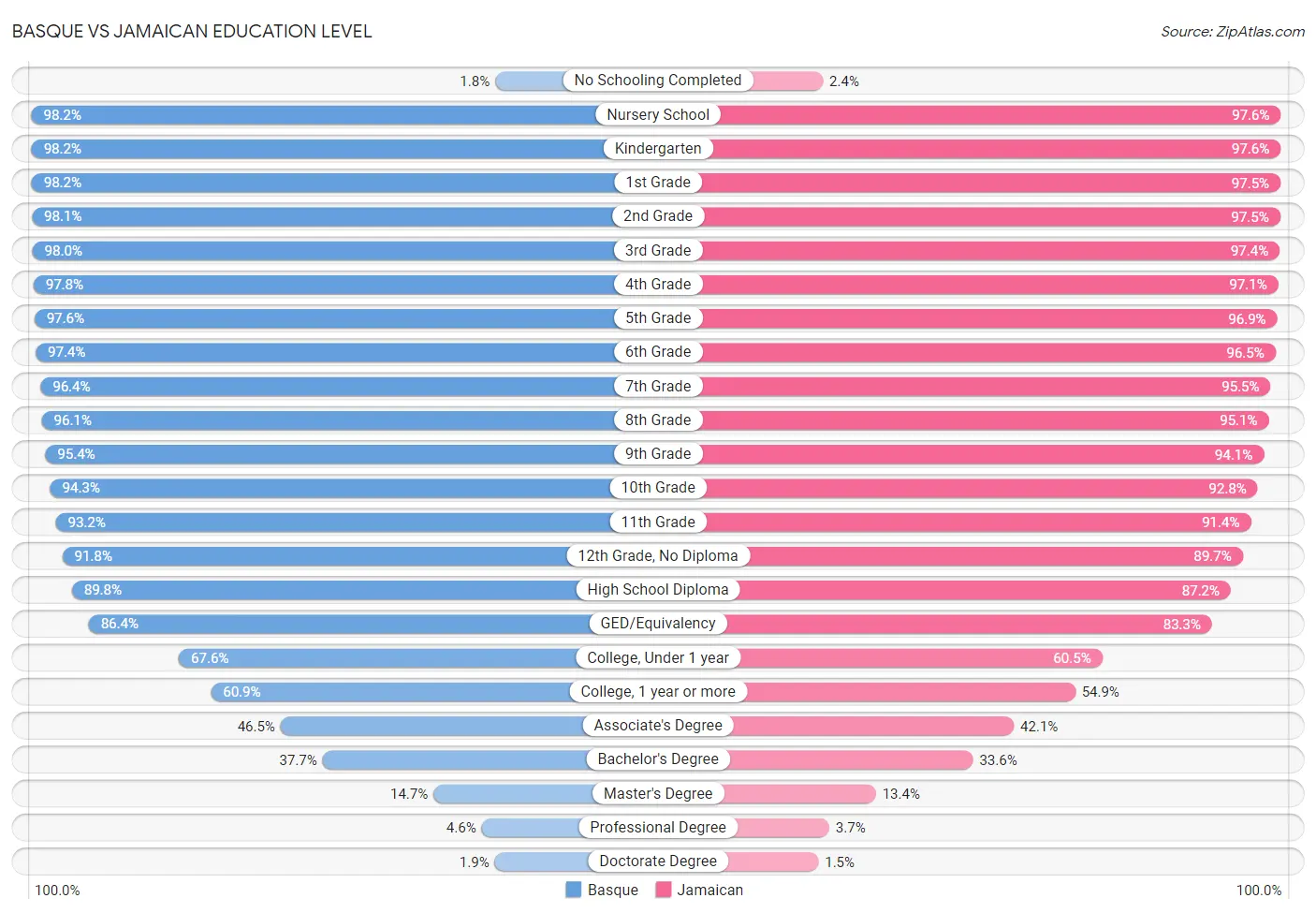
| Education Level Metric | Basque | Jamaican |
| No Schooling Completed | Exceptional 1.8% | Tragic 2.4% |
| Nursery School | Exceptional 98.2% | Tragic 97.6% |
| Kindergarten | Exceptional 98.2% | Tragic 97.6% |
| 1st Grade | Exceptional 98.2% | Tragic 97.5% |
| 2nd Grade | Exceptional 98.1% | Tragic 97.5% |
| 3rd Grade | Exceptional 98.0% | Tragic 97.4% |
| 4th Grade | Exceptional 97.8% | Tragic 97.1% |
| 5th Grade | Exceptional 97.6% | Tragic 96.9% |
| 6th Grade | Exceptional 97.4% | Tragic 96.5% |
| 7th Grade | Excellent 96.4% | Tragic 95.5% |
| 8th Grade | Exceptional 96.1% | Tragic 95.1% |
| 9th Grade | Exceptional 95.4% | Tragic 94.1% |
| 10th Grade | Exceptional 94.3% | Tragic 92.8% |
| 11th Grade | Exceptional 93.2% | Tragic 91.4% |
| 12th Grade, No Diploma | Exceptional 91.8% | Tragic 89.7% |
| High School Diploma | Excellent 89.8% | Tragic 87.2% |
| GED/Equivalency | Good 86.4% | Tragic 83.3% |
| College, Under 1 year | Exceptional 67.6% | Tragic 60.5% |
| College, 1 year or more | Excellent 60.9% | Tragic 54.9% |
| Associate's Degree | Average 46.5% | Tragic 42.1% |
| Bachelor's Degree | Average 37.7% | Tragic 33.6% |
| Master's Degree | Fair 14.7% | Tragic 13.4% |
| Professional Degree | Excellent 4.6% | Tragic 3.7% |
| Doctorate Degree | Good 1.9% | Tragic 1.5% |
Basque vs Jamaican Disability
When considering disability, the most significant differences between Basque and Jamaican communities in the United States are seen in hearing disability (3.6% compared to 2.7%, a difference of 34.6%), disability age 18 to 34 (7.4% compared to 6.4%, a difference of 15.5%), and self-care disability (2.4% compared to 2.7%, a difference of 10.7%). Conversely, both communities are more comparable in terms of disability age over 75 (47.6% compared to 47.7%, a difference of 0.36%), disability (12.2% compared to 12.1%, a difference of 0.84%), and disability age 65 to 74 (23.5% compared to 24.0%, a difference of 2.2%).
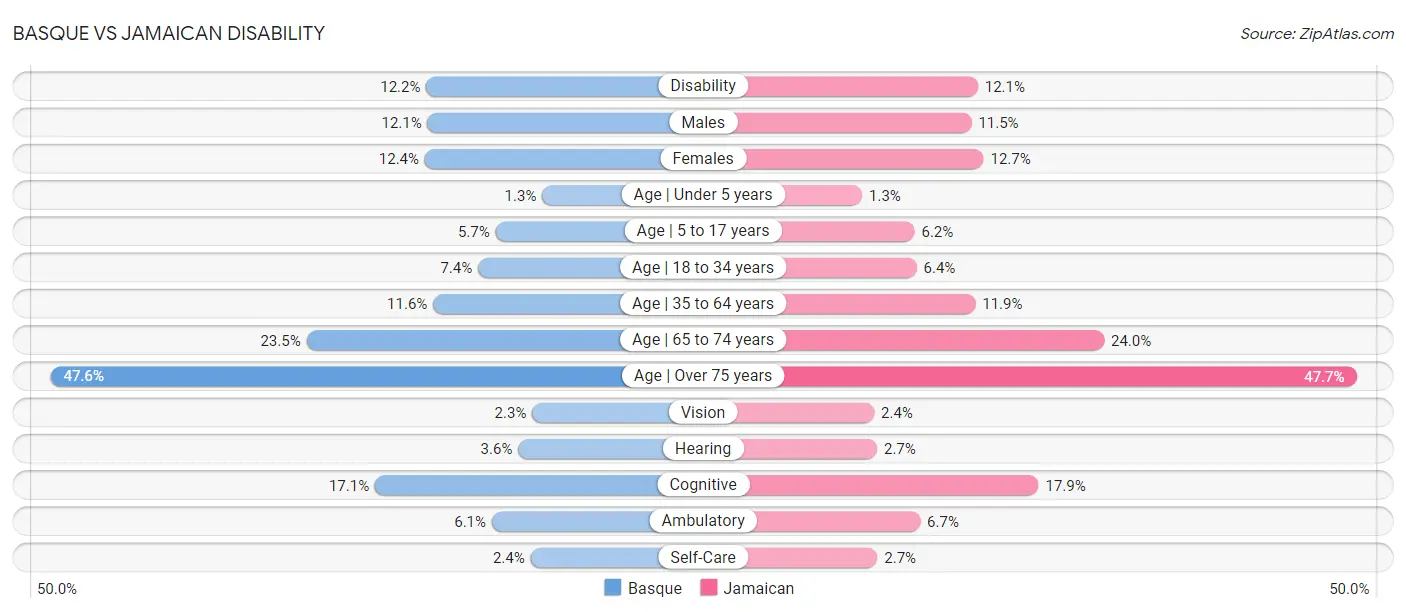
| Disability Metric | Basque | Jamaican |
| Disability | Tragic 12.2% | Tragic 12.1% |
| Males | Tragic 12.1% | Poor 11.5% |
| Females | Poor 12.4% | Tragic 12.7% |
| Age | Under 5 years | Tragic 1.3% | Fair 1.3% |
| Age | 5 to 17 years | Poor 5.7% | Tragic 6.2% |
| Age | 18 to 34 years | Tragic 7.4% | Excellent 6.4% |
| Age | 35 to 64 years | Poor 11.6% | Tragic 11.9% |
| Age | 65 to 74 years | Fair 23.5% | Poor 24.0% |
| Age | Over 75 years | Fair 47.6% | Poor 47.7% |
| Vision | Tragic 2.3% | Tragic 2.4% |
| Hearing | Tragic 3.6% | Exceptional 2.7% |
| Cognitive | Excellent 17.1% | Tragic 17.9% |
| Ambulatory | Good 6.1% | Tragic 6.7% |
| Self-Care | Good 2.4% | Tragic 2.7% |